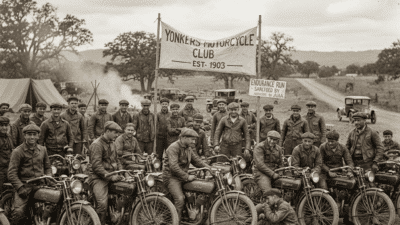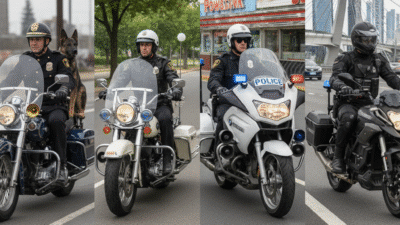Feel the wind in your hair, the rumble beneath you, the sheer exhilaration of the open road. Motorcycling is more than just transport; it’s a passion, a lifestyle, a symphony of freedom and adrenaline. But with such power comes responsibility, and nowhere is that more evident than in the incredible evolution of motorcycle safety gear. What began as rudimentary protection has transformed into a marvel of engineering, weaving together cutting-edge technology, revolutionary materials, and thoughtful design to keep riders safer than ever before. Prepare to be amazed as we journey through the thrilling history of gear that has redefined rider protection.
The Formative Years: Leather and rudimentary Logic
In the early days of motorcycling, protection was largely an afterthought, or at best, an improvisation. Riders were pioneers, pushing boundaries on machines that were, by modern standards, rudimentary and often unpredictable. The concept of specialized safety gear was almost non-existent.
The Humble Beginnings
Picture the roaring twenties and thirties. Motorcyclists often donned what they had readily available: heavy leather jackets, thick gloves, and sturdy boots. These items weren’t designed specifically for crash protection, but rather for warmth, abrasion resistance against the elements, and a modicum of impact protection from road debris. Leather, an age-old material, proved its worth early on. Its natural toughness offered a decent barrier against scrapes and slides, earning it a permanent place in the rider’s wardrobe. However, without dedicated padding or reinforced stitching, its protective capabilities were limited. Helmets, when worn, were often simple leather caps, offering little more than a shield from the wind and perhaps a minor bump. The focus was predominantly on the machine itself, with little scientific understanding of impact dynamics or injury prevention.
The Limitations of Early Gear
While stylish and iconic, this early gear had significant drawbacks. Impact protection was virtually non-existent. A fall at even moderate speeds could lead to severe head injuries, broken bones, and extensive road rash. The lack of ventilation meant riders often overheated in warm weather, and the sheer bulk of the clothing could restrict movement, potentially affecting control. There was no standardization, no regulatory bodies, and no scientific testing. Riders relied on luck, skill, and the inherent toughness of their leather to see them through. This era, while romanticized, underscored the desperate need for more deliberate and effective safety solutions as motorcycles gained speed and popularity. For a glimpse into the very origins of these magnificent machines, consider the first steam-powered two-wheeler and the birth of the motorcycle.

The Mid-Century Shift: Innovation Takes Hold
As the mid-20th century dawned, a growing awareness of rider safety began to emerge. The increasing speeds and prevalence of motorcycles on public roads highlighted the shortcomings of existing gear. This period marked a pivotal shift, driven by military research, technological advancements, and a deeper understanding of human biomechanics.
From Natural to Synthetic
The post-World War II era brought a wealth of new materials and manufacturing techniques. Synthetic fabrics began to challenge leather’s dominance. While leather remained a staple, the introduction of materials like nylon and later, Cordura, offered lightweight alternatives with excellent abrasion resistance. These materials could be woven in different densities and combined with other elements to enhance protection without sacrificing comfort or flexibility. This opened the door for more complex garment designs that could integrate padding more effectively.
Helmet Revolution
Perhaps the most significant leap in mid-century safety gear was the advent of the modern helmet. Inspired by combat helmet technology, companies began to develop hard-shell helmets with energy-absorbing liners. In 1953, Professor Hugh DeHaven’s research on impact injuries led to the development of the first commercial motorcycle helmet by Bell Helmets. This groundbreaking design featured a rigid outer shell and a crucial inner liner made of expanded polystyrene (EPS) foam, engineered to crush and absorb impact energy, dramatically reducing the forces transmitted to the skull. This innovation literally saved lives and quickly became a non-negotiable piece of gear for serious riders. Regulations and standards slowly began to emerge, pushing for mandatory helmet use and improved designs.
Body Armor Emerges
Beyond helmets, the concept of dedicated body armor started taking shape. While rudimentary, padding for elbows, shoulders, and knees began to be integrated into jackets and trousers. These early pads were often made of dense foam or hard plastic, designed to dissipate impact energy. Though still bulky, they represented a conscious effort to protect critical joints and bones, moving beyond simple abrasion resistance to address direct impact injuries. The evolution from mere clothing to genuine protective equipment was well underway, setting the stage for even more sophisticated advancements.
The Modern Era: Advanced Materials and Design
The late 20th and early 21st centuries have witnessed an explosion of innovation, transforming motorcycle safety gear into high-tech, performance-driven equipment. The focus has expanded to include not only protection but also comfort, aerodynamics, and connectivity.
The Science of Protection
Modern motorcycle gear is a testament to material science. Kevlar, Cordura, and Dyneema are household names among riders, offering incredible abrasion resistance without the bulk of traditional heavy leather. These synthetic fibers, often blended or strategically placed, provide a lightweight yet incredibly strong barrier against road rash. Beneath the surface, impact absorbers have become highly sophisticated. Visco-elastic polymers, D3O, SAS-TEC, and other advanced foams are engineered to be soft and flexible in their natural state, allowing for comfortable movement. However, upon impact, their molecules lock together, instantly hardening to absorb and dissipate energy before returning to their flexible state. This dynamic protection is a game-changer, offering superior impact absorption compared to earlier rigid plastics. Back protectors, chest protectors, and joint armor are now standard, meticulously designed to cover vulnerable areas.

Weatherproofing Wonders
Riding isn’t just about crashes; it’s about comfort in all conditions. Materials like Gore-Tex and other proprietary waterproof-breathable membranes have revolutionized all-weather riding. These fabrics prevent rain from penetrating while allowing sweat vapor to escape, keeping riders dry and comfortable. Durable Water Repellent (DWR) coatings further enhance this, causing water to bead up and roll off the fabric’s surface. This focus on weather protection significantly improves rider comfort, reduces fatigue, and ensures concentration, which is a crucial aspect of overall safety. Learning how to navigate different conditions is key, and understanding tips for riding a motorcycle in the rain and wet weather can make a world of difference.
The Importance of Certification
Today, safety gear isn’t just advertised as protective; it’s rigorously tested and certified. CE (Conformité Européenne) ratings have become the global standard, ensuring that helmets, jackets, pants, gloves, and boots meet stringent performance requirements for impact absorption and abrasion resistance. Gear is typically rated to different levels (e.g., CE Level 1 or Level 2 for armor), providing riders with clear benchmarks for the level of protection offered. This standardization offers peace of mind and empowers riders to make informed choices about their equipment.
Pros and Cons
| Pros | Cons |
|---|---|
| – Dramatically increased protection against impact and abrasion | – Higher cost for advanced materials and technology |
| – Enhanced comfort through ventilation, flexibility, and weatherproofing | – Gear can still be bulky or heavy, especially with full armor |
| – Integration of smart technology for communication and active safety | – Requires regular maintenance and care to retain effectiveness |
| – Wide range of styles and specialized gear for different riding types | – Can sometimes restrict full range of motion, impacting agility |
| – Standardization and certification provide clear safety benchmarks | – Rapid technological advancements can quickly make older gear seem outdated |
Smart Gear and Connected Riding: The Digital Age of Safety
The digital revolution has seamlessly integrated into motorcycle safety, pushing boundaries far beyond passive protection. Welcome to an era where your gear doesn’t just protect you after an impact, but actively works to prevent one and connect you to the world.
Airbag Technology: A Game Changer
Perhaps one of the most significant advancements in active safety gear is the integration of airbag technology. Initially seen in high-level racing (think MotoGP), these systems are now widely available to the general public. Embedded in vests or jackets, these sophisticated systems use an array of sensors (accelerometers, gyroscopes, GPS) to detect a crash or imminent impact within milliseconds. Upon detection, CO2 cartridges rapidly inflate airbags around critical areas like the neck, shoulders, chest, and back, creating a cushioning barrier that dramatically reduces impact forces. Studies have shown these systems can reduce the risk of critical injuries by a significant margin. Some systems are tethered to the bike, while others are entirely wireless, using complex algorithms to differentiate between a fall and a simple dismount. This active form of protection is truly revolutionary, bringing an unprecedented level of safety to the rider. High-performance events like MotoGP vs. World Superbike have been crucial testing grounds for these innovations.
Smart Helmets: Beyond Basic Protection
Helmets have always been the cornerstone of rider safety, but “smart helmets” take this to an entirely new dimension. These futuristic lids integrate a range of technologies designed to enhance awareness, communication, and even navigation. Features can include:
- Integrated Communication Systems: Bluetooth intercoms allow riders to communicate with passengers or other riders, make calls, and listen to music without fumbling with their phone.
- Heads-Up Displays (HUDs): Projecting vital information like speed, navigation directions, and incoming calls directly onto the visor, keeping the rider’s eyes on the road.
- Rear-View Cameras: Displaying a live feed of what’s behind the rider, eliminating blind spots and improving situational awareness.
- Emergency Call Systems: Automatically notifying emergency services in the event of a crash, often with GPS coordinates.
These innovations aren’t just gadgets; they are designed to reduce distractions and provide critical information, making the riding experience safer and more integrated.

Integrated Communication Systems
Beyond smart helmets, integrated communication systems have become a standard feature for many riders. These intercom units, often seamlessly built into helmets or clipped onto them, connect riders to their passengers, fellow riders in a group, or even their smartphones. This allows for clear communication, access to GPS navigation, music streaming, and hands-free calls, all without needing to take hands off the handlebars or eyes off the road. The ability to coordinate with other riders, especially in challenging environments, significantly enhances group safety and overall enjoyment.

Future Forward: What’s Next in Motorcycle Safety
The evolution of motorcycle safety gear is far from over. As technology continues its relentless march forward, we can anticipate even more groundbreaking innovations that promise to redefine protection and enhance the riding experience in ways we can only begin to imagine. The future of motorcycle safety is an exciting blend of AI, advanced materials, and seamless connectivity.
AI and Predictive Safety
Imagine gear that not only reacts to a crash but actively helps prevent it. Artificial intelligence and machine learning are poised to revolutionize predictive safety. Future systems might analyze riding patterns, road conditions (via sensors in the bike and gear), and even rider fatigue levels. For example, AI-powered gear could:
- Alert riders to impending hazards: Integrating with vehicle-to-everything (V2X) communication, smart helmets or jackets could warn riders of sudden braking vehicles ahead, slippery patches, or merging traffic from blind spots.
- Optimize gear performance: Continuously adjust ventilation, heating, or even the stiffness of protective elements based on real-time data from the rider and environment.
- Fatigue detection: Sensors could monitor rider vital signs and head movements, issuing alerts if signs of fatigue are detected, suggesting a rest break.
This proactive approach moves beyond passive protection, making safety an active, adaptive system.

Adaptive and Self-Healing Materials
Material science continues to push boundaries. We might see the emergence of adaptive materials that can change their properties on demand. Imagine armor that becomes instantly rigid upon detecting a high-stress situation, then softens again for comfort. Even more sci-fi concepts include self-healing materials that can repair minor abrasions or tears, extending the life and effectiveness of gear. Nanotechnology could play a role in creating ultra-lightweight yet incredibly strong fabrics that offer unparalleled abrasion resistance with minimal bulk.
Enhanced Visibility and Connectivity
Visibility is paramount for motorcyclists. Future gear will likely integrate more sophisticated active lighting systems, beyond simple reflective strips. Think about jackets with dynamic LED panels that can display brake lights, turn signals, or even emergency warnings, adapting to traffic conditions. V2V (vehicle-to-vehicle) and V2I (vehicle-to-infrastructure) communication will become standard, allowing motorcycles and their riders to “talk” to other vehicles and smart city infrastructure. This means cars could be alerted to a motorcycle’s presence in their blind spot, or traffic lights could optimize their timing to enhance rider safety at intersections. Such connectivity will knit riders into the broader transportation ecosystem, significantly reducing collision risks. This level of integration mirrors advancements seen in various automotive sectors, much like the sophisticated design choices explored in the art of interior car design, blending comfort and innovation.

Conclusion
From rudimentary leather and simple caps to sophisticated smart helmets and airbag suits, the evolution of motorcycle safety gear is a thrilling saga of human ingenuity and an unwavering commitment to rider protection. What started as basic defense against the elements has transformed into an intricate ecosystem of materials, technology, and design, all working in harmony to mitigate risks and enhance the joy of riding.
The journey has been incredible, driven by a deep understanding of impact physics, biomechanics, and the relentless pursuit of innovation. Every stitch, every layer, every microchip is there to ensure that when you hit the open road, you do so with confidence, knowing you’re protected by the best technology humanity has to offer. The future promises even more astonishing advancements, blurring the lines between protection, prevention, and seamless connectivity. So, gear up, ride safe, and embrace the next chapter in this remarkable evolution. The road ahead is not just exciting; it’s safer than ever before! Before your next ride, always remember to perform a thorough pre-ride safety inspection of your motorcycle to ensure everything is in top condition.
Frequently Asked Questions
What was the earliest form of motorcycle safety gear?
The earliest forms of motorcycle safety gear were primarily heavy leather jackets, thick gloves, and sturdy boots. These items were not specifically designed for crash protection but offered some abrasion resistance and protection from the elements. Helmets were often simple leather caps, providing minimal impact protection.
How did helmets evolve to become so effective?
Modern helmets evolved significantly with the introduction of hard outer shells and energy-absorbing inner liners, typically made of expanded polystyrene (EPS) foam. Pioneering research in the 1950s led to designs that crush on impact, dissipating energy and dramatically reducing forces on the skull, a major improvement over earlier simple caps.
What are CE ratings in motorcycle gear?
CE (Conformité Européenne) ratings are standardized certifications that indicate motorcycle safety gear has met stringent European performance requirements for impact absorption and abrasion resistance. Gear is typically rated to different levels (e.g., CE Level 1 or Level 2 for armor) to help riders understand the level of protection offered.
How do modern airbag systems in motorcycle gear work?
Modern airbag systems use an array of sensors (accelerometers, gyroscopes, GPS) embedded in vests or jackets to detect a crash or imminent impact within milliseconds. Once detected, CO2 cartridges rapidly inflate airbags around critical areas like the neck, shoulders, chest, and back, creating a cushioning barrier that significantly reduces impact forces.
What are some features of “smart helmets”?
Smart helmets integrate various technologies to enhance rider awareness and communication. Features can include integrated Bluetooth communication systems for intercom and phone calls, Heads-Up Displays (HUDs) for navigation and speed, rear-view cameras to eliminate blind spots, and even automatic emergency call systems that notify services in case of a crash.
What future innovations can we expect in motorcycle safety gear?
The future of motorcycle safety gear is expected to include AI and machine learning for predictive safety (e.g., hazard alerts, fatigue detection), adaptive and self-healing materials that can change properties or repair themselves, and enhanced visibility through dynamic LED lighting and extensive V2V/V2I (vehicle-to-vehicle/infrastructure) communication for a more connected and safer riding experience.



